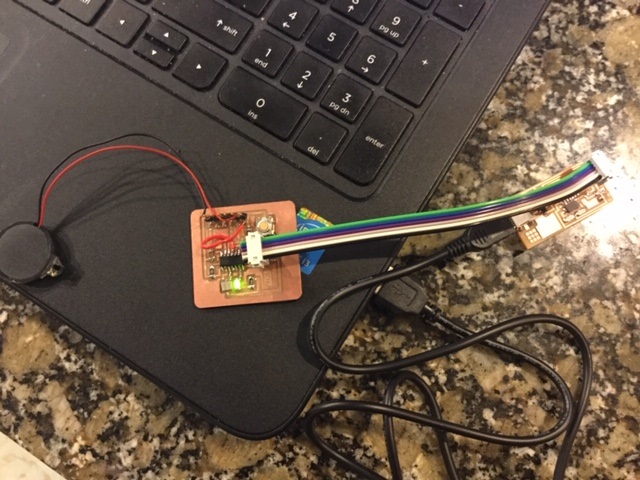9. Embedded programming (Obtainium Music)¶
This week I worked on reading the ATTiny44 data sheet and programmed my board (using C++) to play music when the button was touched…
Research¶
Obtainium: Material used to create, that wasn’t bought new, but obtained in other ways, such as second-hand, dumpster diving, chance findings or donations. Obtainium users create from things that others throw away, I call what I did for this project Obtainium Music.
Useful links¶
Code Example¶
// constants won't change. They're used here to
// set pin numbers:
const int buttonPin = 3; // the number of the pushbutton pin
const int ledPin = 7; // the number of the LED pin
// variables will change:
int buttonState = 0; // variable for reading the pushbutton status
int speakerOut = 2; // The number of the Speaker
byte names[] = {'c', 'd', 'e', 'f', 'g', 'a', 'b', 'C'};
int tones[] = {1915, 1700, 1519, 1432, 1275, 1136, 1014, 956};
byte melody[] = "2d2a1f2c2d2a2d2c2f2d2a2c2d2a1f2c2d2a2a2g2p8p8p8p";
// count length: 1 2 3 4 5 6 7 8 9 0 1 2 3 4 5 6 7 8 9 0 1 2 3 4 5 6 7 8 9 0
// 10 20 30
int count = 0;
int count2 = 0;
int count3 = 0;
int MAX_COUNT = 24;
int statePin = LOW;
void setup() {
// initialize the LED pin as an output:
pinMode(ledPin, OUTPUT);
// initialize the pushbutton pin as an input:
pinMode(buttonPin, INPUT);
}
void loop() {
// read the state of the pushbutton value:
buttonState = digitalRead(buttonPin);
// check if the pushbutton is pressed.
// if it is, the buttonState is HIGH:
if (buttonState == HIGH) {
// turn LED on:
digitalWrite(ledPin, HIGH);
}
else {
// turn LED off:
digitalWrite(ledPin, LOW);
delay(250);
analogWrite(speakerOut, 0);
for (count = 0; count < MAX_COUNT; count++) {
statePin = !statePin;
digitalWrite(ledPin, statePin);
for (count3 = 0; count3 <= (melody[count*2] - 48) * 30; count3++) {
for (count2=0;count2<8;count2++) {
if (names[count2] == melody[count*2 + 1]) {
analogWrite(speakerOut,500);
delayMicroseconds(tones[count2]);
analogWrite(speakerOut, 0);
delayMicroseconds(tones[count2]);
}
if (melody[count*2 + 1] == 'p') {
// make a pause of a certain size
analogWrite(speakerOut, 0);
delayMicroseconds(500);
}
}
}
}
}
}
Gallery¶
For this week assignment, I used our Hello world modified board ( with the added button and Led) and attached a buzzer (that belonged to one of my Daughters destroyed toys) to the pin 11.
The pin 11 according to the ATTiny44 Datasheet corresponds to the Port A driver 2 of the Microcontroller. So, I modified the program used in the week 7 assignment to play a series of tones
whenever the button was pressed.
By adding/recovering a component from a destroyed toy, that otherwise would have been discarded in the trash, we gave new life to this Obtainium Music Generator…
From Youtube¶
Playing Obtainium Music....

